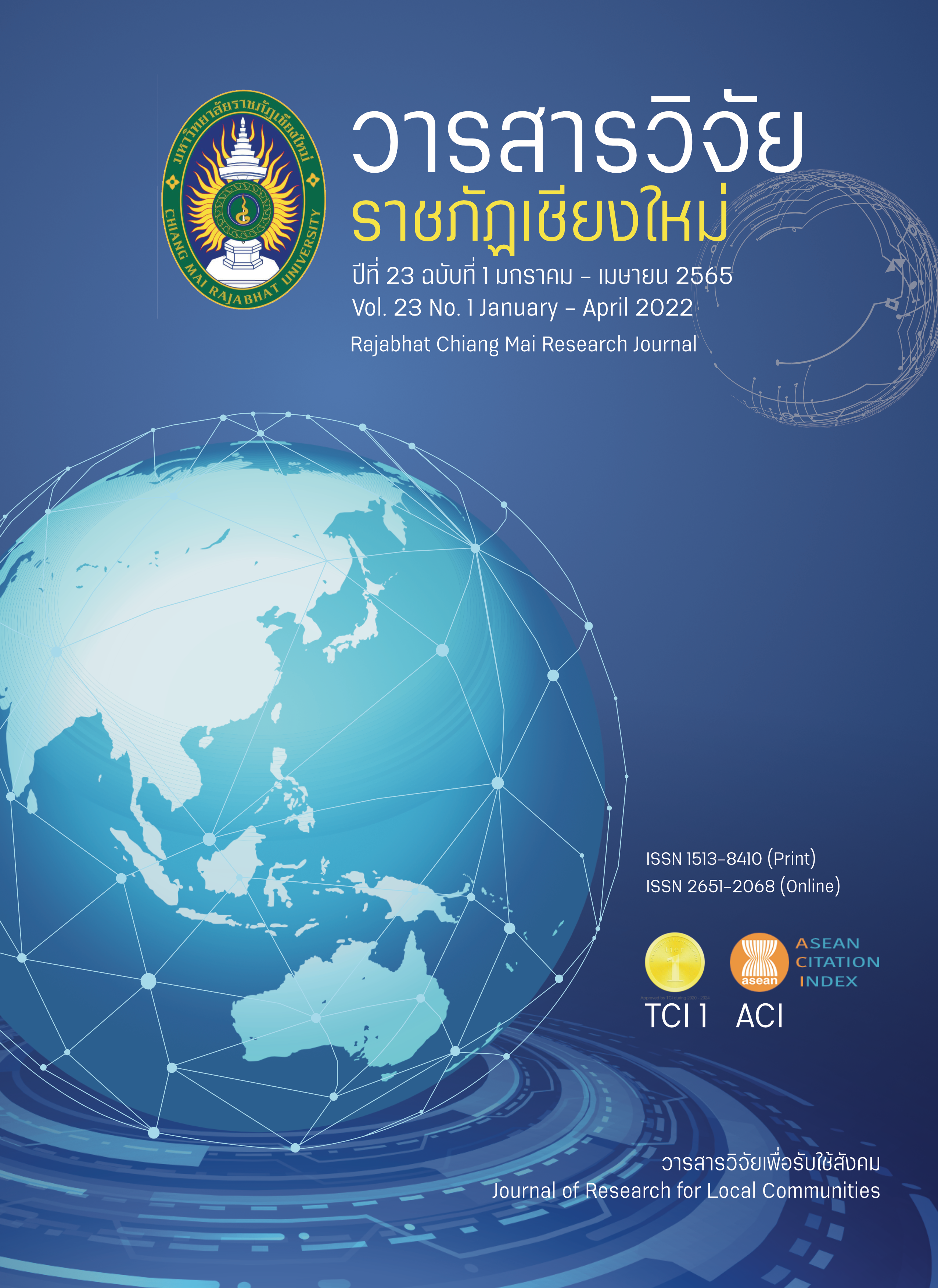แนวทางการพัฒนารูปแบบการจัดการความปลอดภัยที่ส่งผลต่อเหตุการณ์ความปลอดภัยของการท่องเที่ยว และวิกฤตการณ์ของนักท่องเที่ยวหญิงชาวต่างชาติ ในแหล่งท่องเที่ยวของจังหวัดสุราษฎร์ธานี
DOI:
https://doi.org/10.14456/rcmrj.2022.247532คำสำคัญ:
การจัดการรูปแบบความปลอดภัย , แนวทางความปลอดภัย , นักท่องเที่ยวหญิงชาวต่างชาติบทคัดย่อ
การวิจัยครั้งนี้มีวัตถุประสงค์เพื่อ (1) ศึกษาระดับความสำคัญของประเด็นความไม่ปลอดภัยของนักท่องเที่ยวหญิงชาวต่างชาติในแหล่งท่องเที่ยวของจังหวัดสุราษฎร์ธานี (2) ศึกษาเปรียบเทียบระดับความสำคัญของประเด็นความไม่ปลอดภัยจำแนกตามปัจจัยส่วนบุคคลของนักท่องเที่ยวชาวต่างชาติเพศหญิง และ (3) ศึกษาแนวทางการจัดการความปลอดภัยของนักท่องเที่ยวหญิงชาวต่างชาติในแหล่งท่องเที่ยวของจังหวัดสุราษฎร์ธานี เป็นการวิจัยแบบผสมผสานเชิงปริมาณ และเชิงคุณภาพ กลุ่มตัวอย่างการวิจัยเชิงปริมาณ คือ นักท่องเที่ยวหญิงชาวต่างชาติที่เดินทางมาท่องเที่ยวในจังหวัดสุราษฎร์ธานีจำนวน 384 คน กลุ่มตัวอย่างการวิจัยเชิงคุณภาพ คือ ผู้ที่มีส่วนเกี่ยวกับการพัฒนารูปแบบการจัดการความปลอดภัยในแหล่งท่องเที่ยว รวมทั้งสิ้น 21 คน เครื่องมือที่ใช้ในการรวบรวมข้อมูล ได้แก่ แบบสอบถาม แบบสนทนากลุ่ม แบบสังเกตอย่างมีส่วนร่วม และแบบสัมภาษณ์
ผลการศึกษา พบว่า (1) ระดับความสำคัญของประเด็นความไม่ปลอดภัยของนักท่องเที่ยวหญิงชาวต่างชาติในแหล่งท่องเที่ยวของจังหวัดสุราษฎร์ธานี ทุกด้านอยู่ในระดับสำคัญมาก นักท่องเที่ยวหญิงชาวต่างชาติในแหล่งท่องเที่ยวของจังหวัดสุราษฎร์ธานีไม่เลือกมาเที่ยวถ้ามีเหตุการณ์การลักพาตัว การก่อการร้ายระหว่างประเทศ ความไม่ปลอดภัยระหว่างเดินทางไปและกลับ ความเสียหายต่อทัศนียภาพที่เกิดจากเหตุการณ์ความไม่ปลอดภัย และความไม่ปลอดภัยในแหล่งทรัพยากรการท่องเที่ยวธรรมชาติ (2) ปัจจัยส่วนบุคคลของนักท่องเที่ยวทั้งอายุ อาชีพ การศึกษา เงินเดือน และทวีป ส่งผลต่อความไม่ปลอดภัย ส่วนใหญ่แตกต่างกันอย่างมีนัยสำคัญทางสถิติ และ (3) แนวทางการจัดการความปลอดภัย พบว่า การดูแล และเพิ่มความสว่างตามสถานที่ท่องเที่ยว การเพิ่มป้ายภาษาอังกฤษ การเพิ่มศูนย์ดูแลนักท่องเที่ยวเฉพาะผู้หญิงต่างชาติ และการประชาสัมพันธ์เกี่ยวกับความเสี่ยงในสถานท่องเที่ยวจะทำให้นักท่องเที่ยวเพิ่มมากขึ้น ดังนั้น ทุกหน่วยงานควรมีการบูรณาการองค์ความรู้ระหว่างกัน การสร้างบุคลากรมืออาชีพ เพิ่มความรวดเร็วผ่านสื่อเทคโนโลยีที่ทันสมัย และบริหารจัดการเมื่อเกิดวิกฤตในช่วงเทศกาลอีกด้วย
Downloads
เอกสารอ้างอิง
Aiemtrakool, P., Kritayanukul, P., & Noosut, T. (2015). Travel behavior and tourist satisfaction of foreign tourist affected safety journeys in Thailand. Journal of Thai Hospitality and Tourism, 10(1), 88-105. (In Thai)
Chitphong, S. (2018). Safety conditions problem effecting international tourists visiting Bangkok in participating in tourism activities. Thesis for Master of Business Administration, Graduate School, Silpakorn University. (In Thai)
Coombs, W. T. (2010). Sustainability: A new and complex “challenge” for crisis managers. International Journal of Sustainable Strategic Management, 2, 4-16.
Davijit, R. (2016). Safety factors affecting decisions to travel in Songkhla Province of foreigners passing the Sadao Border. Journal of the College of Logistics and Supply Chain, 3(2), 63-75.
Heinrich, H. W. (1931). Industrial accident prevention: A scientific approach. New York: McGraw- Hill.
Kasum, J., Mikulicic, J. Z., & Jugovic, A. (2018). Distribution of maritime safety information and improvement measures for safety of navigation. International Journal of Maritime Science & Technology, 65(3), 164-168.
Khamsee, N. & Wattanakamolchai, S. (2018). The influence of perception of destination safety through social media on tourist’s decisions to travel to Chiang Mai, Thailand. M. A. (Hospitality and Tourism Industry Management). (In Thai)
Lertwuthirak, N. (2018). The main factors affecting modern tourism behavior. Retrieved from https://www.marketingoops.com/exclusive/insider-exclusive/factors-affecting-chinese- tourist-behavior/. (In Thai)
Lutz, J. & Ryan, C. (1993). Hotels and the businesswoman: an analysis of businesswomen’s perceptions of hotel services. Tourism Management, 14(5), 349-359.
Mansfeld, Y. & Pizam, A. (2006). Tourism, security and safety: From theory to practice. UK: Butterwortheinemann.
Nimsuwan, N. & Boonrat, A. (2020). Causes of insecurity of tourism in Hat Yai, Songkhla Journal of Thai Hospitality and Tourism, 15(1), 46-57. (In Thai)
Rojrungsat, P. (2013). Importance and communicative learning activities through food tourism for international women market tourists of Thailand. Journal of Thai Hospitality & Tourism, 8(1), 61-72.
Saengthongdee, T. (2018). Tourist safety models in tourism in Ayutthaya Province. Journal of Criminology and Forensic Science, 4(2), 22-38. (In Thai)
Surat Thani Provincial Development Strategy Committee. (2021). 20-year development plan for Surat Thani Province (2017-2036). Retrieved from http://123.242.172.6/yuttasat/document/plan20y.pdf. (In Thai)
Surat Thani Provincial Statistical Office. (2020). Provincial Statistical Management. Retrieved from http://surat.nso.go.th/index.php?option=com_content&view=article&id=266&Itemid=606. (In Thai)
Taekatook, T. (2018). The development of a road accident reporting system in the form of a mobile application to support the e-report system of the road safety center. Isranews Agency. Retrieved from https://www.isranews.org/isranews-article/67605-aticle-67605.html. (In Thai)
Thanapatsiri, P. (2016). Management of life and property safety for tourists by Phuket tourist police. Phuket Rajabhat University Academic Journal, 1(16), 123-150. (In Thai)
Udomsilp, M, & Sungrugsa, N. (2016). Safety management of travel tourism in the western region towards ASEAN Community: Revisited to mission? Veridian E-Journal. Silpakorn University, 9(3), 260-270. (In Thai)
UNWTO. (2010). Global report on women in tourism 2010. Retrieved from http://www2.unwto.org/sites/all/files/pdf/folleto_globarl_report.pdf.
World Economic Forum. (2017). Annual Report 2017-2018. Retrieved from https://www.weforum.org/reports/annual-report-2016-2017.
Yuvanatemiya, V. (2015). Risk perception of international tourist in Thailand. M.A. Tourism Management. Dhurakij Pundit University. (In Thai)
ดาวน์โหลด
เผยแพร่แล้ว
รูปแบบการอ้างอิง
ฉบับ
ประเภทบทความ
สัญญาอนุญาต
ลิขสิทธิ์ (c) 2022 วารสารวิจัยราชภัฏเชียงใหม่

อนุญาตภายใต้เงื่อนไข Creative Commons Attribution-NonCommercial-NoDerivatives 4.0 International License.
1. บทความ ข้อมูล เนื้อหา รูปภาพ ฯลฯ ที่ได้รับการตีพิมพ์ใน “Community and Social Development Journal” ถือเป็นลิขสิทธิ์ของ Community and Social Development Journal มหาวิทยาลัยราชภัฏเชียงใหม่ และเพื่อให้เผยแพร่บทความได้อย่างเหมาะสมผ่านสื่อสิ่งพิมพ์และอิเล็กทรอนิกส์ ผู้เขียนยังคงถือครองลิขสิทธิ์บทความที่ตีพิมพ์ภายใต้ใบอนุญาต Creative Commons Attribution (CC BY) ซึ่งอนุญาตให้เผยแพร่บทความซ้ำในแหล่งอื่นได้ โดยอ้างอิงต้องอ้งอิงบทความในวารสาร ผู้เขียนต้องรับผิดชอบในการขออนุญาตผลิตซ้ำเนื้อหาที่มีลิขสิทธิ์จากแหล่งอื่น
2. เนื้อหาบทความที่ปรากฏในวารสารเป็นความรับผิดชอบของผู้เขียนบทความโดยตรง ซึ่งกองบรรณาธิการวารสารไม่จำเป็นต้องเห็นด้วยหรือร่วมรับผิดชอบใดๆ














